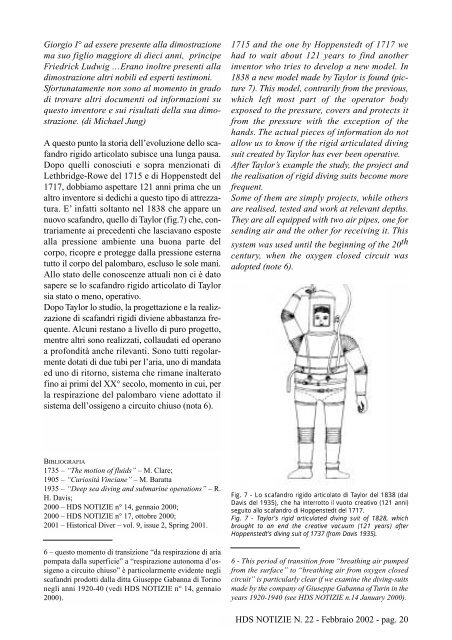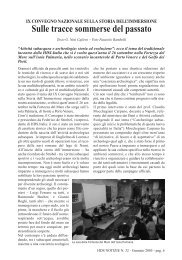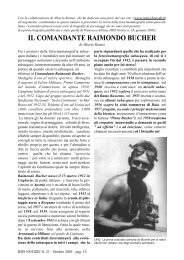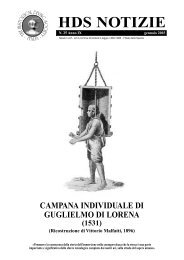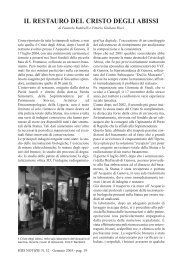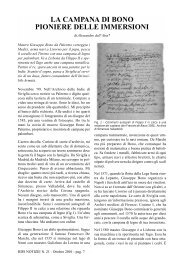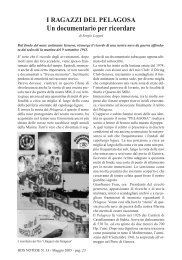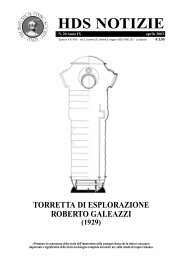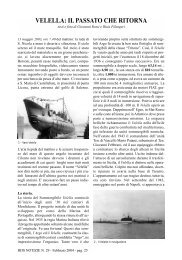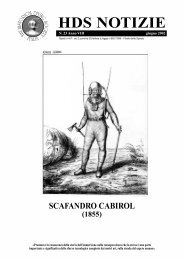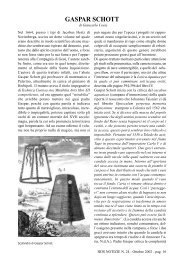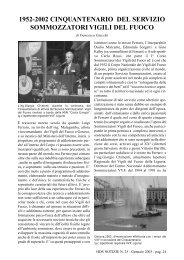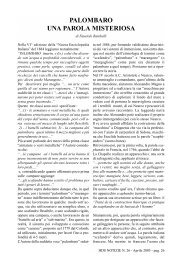hds internet - The Historical Diving Society Italia
hds internet - The Historical Diving Society Italia
hds internet - The Historical Diving Society Italia
Create successful ePaper yourself
Turn your PDF publications into a flip-book with our unique Google optimized e-Paper software.
Giorgio I° ad essere presente alla dimostrazione<br />
ma suo figlio maggiore di dieci anni, principe<br />
Friedrick Ludwig …Erano inoltre presenti alla<br />
dimostrazione altri nobili ed esperti testimoni.<br />
Sfortunatamente non sono al momento in grado<br />
di trovare altri documenti od informazioni su<br />
questo inventore e sui risultati della sua dimostrazione.<br />
(di Michael Jung)<br />
A questo punto la storia dell’evoluzione dello scafandro<br />
rigido articolato subisce una lunga pausa.<br />
Dopo quelli conosciuti e sopra menzionati di<br />
Lethbridge-Rowe del 1715 e di Hoppenstedt del<br />
1717, dobbiamo aspettare 121 anni prima che un<br />
altro inventore si dedichi a questo tipo di attrezzatura.<br />
E’ infatti soltanto nel 1838 che appare un<br />
nuovo scafandro, quello di Taylor (fig.7) che, contrariamente<br />
ai precedenti che lasciavano esposte<br />
alla pressione ambiente una buona parte del<br />
corpo, ricopre e protegge dalla pressione esterna<br />
tutto il corpo del palombaro, escluso le sole mani.<br />
Allo stato delle conoscenze attuali non ci è dato<br />
sapere se lo scafandro rigido articolato di Taylor<br />
sia stato o meno, operativo.<br />
Dopo Taylor lo studio, la progettazione e la realizzazione<br />
di scafandri rigidi diviene abbastanza frequente.<br />
Alcuni restano a livello di puro progetto,<br />
mentre altri sono realizzati, collaudati ed operano<br />
a profondità anche rilevanti. Sono tutti regolarmente<br />
dotati di due tubi per l’aria, uno di mandata<br />
ed uno di ritorno, sistema che rimane inalterato<br />
fino ai primi del XX° secolo, momento in cui, per<br />
la respirazione del palombaro viene adottato il<br />
sistema dell’ossigeno a circuito chiuso (nota 6).<br />
1715 and the one by Hoppenstedt of 1717 we<br />
had to wait about 121 years to find another<br />
inventor who tries to develop a new model. In<br />
1838 a new model made by Taylor is found (picture<br />
7). This model, contrarily from the previous,<br />
which left most part of the operator body<br />
exposed to the pressure, covers and protects it<br />
from the pressure with the exception of the<br />
hands. <strong>The</strong> actual pieces of information do not<br />
allow us to know if the rigid articulated diving<br />
suit created by Taylor has ever been operative.<br />
After Taylor’s example the study, the project and<br />
the realisation of rigid diving suits become more<br />
frequent.<br />
Some of them are simply projects, while others<br />
are realised, tested and work at relevant depths.<br />
<strong>The</strong>y are all equipped with two air pipes, one for<br />
sending air and the other for receiving it. This<br />
system was used until the beginning of the 20 th<br />
century, when the oxygen closed circuit was<br />
adopted (note 6).<br />
BIBLIOGRAFIA<br />
1735 – “<strong>The</strong> motion of fluids” – M. Clare;<br />
1905 – “Curiosità Vinciane” – M. Baratta<br />
1935 – “Deep sea diving and submarine operations” – R.<br />
H. Davis;<br />
2000 – HDS NOTIZIE n° 14, gennaio 2000;<br />
2000 – HDS NOTIZIE n° 17, ottobre 2000;<br />
2001 – <strong>Historical</strong> Diver – vol. 9, issue 2, Spring 2001.<br />
6 – questo momento di transizione “da respirazione di aria<br />
pompata dalla superficie” a “respirazione autonoma d’ossigeno<br />
a circuito chiuso” è particolarmente evidente negli<br />
scafandri prodotti dalla ditta Giuseppe Gabanna di Torino<br />
negli anni 1920-40 (vedi HDS NOTIZIE n° 14, gennaio<br />
2000).<br />
Fig. 7 - Lo scafandro rigido articolato di Taylor del 1838 (dal<br />
Davis del 1935), che ha interrotto il vuoto creativo (121 anni)<br />
seguito allo scafandro di Hoppenstedt del 1717.<br />
Fig. 7 - Taylor’s rigid articulated diving suit of 1828, which<br />
brought to an end the creative vacuum (121 years) after<br />
Hoppenstedt’s diving suit of 1737 (from Davis 1935).<br />
6 - This period of transition from “breathing air pumped<br />
from the surface” to “breathing air from oxygen closed<br />
circuit” is particularly clear if we examine the diving-suits<br />
made by the company of Giuseppe Gabanna of Turin in the<br />
years 1920-1940 (see HDS NOTIZIE n.14 January 2000).<br />
HDS NOTIZIE N. 22 - Febbraio 2002 - pag. 20


